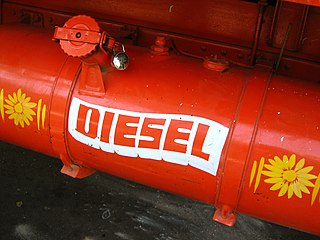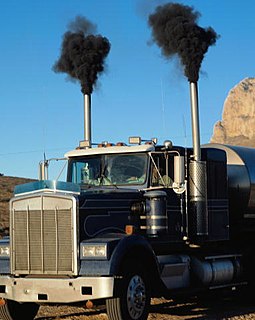Related Research Articles

Diesel fuel in general is any liquid fuel specifically designed for use in diesel engines, whose fuel ignition takes place, without any spark, as a result of compression of the inlet air mixture and then injection of fuel. Therefore, diesel fuel needs good compression ignition characteristics.

Fuel oil is a fraction obtained from petroleum distillation. It includes distillates - the lighter fractions, and residues - the heavier fractions.
The California Air Resources Board is the "clean air agency" in the government of California. Established in 1967 when then-governor Ronald Reagan signed the Mulford-Carrell Act, combining the Bureau of Air Sanitation and the Motor Vehicle Pollution Control Board, CARB is a department within the cabinet-level California Environmental Protection Agency.

Emission standards are the legal requirements governing air pollutants released into the atmosphere. Emission standards set quantitative limits on the permissible amount of specific air pollutants that may be released from specific sources over specific timeframes. They are generally designed to achieve air quality standards and to protect human life. Different regions and countries have different standards for vehicle emissions.
A partial zero emission vehicle, in the United States, is an automobile that has zero evaporative emissions from its fuel system, has a 15-year warranty on its emission-control components, and meets SULEV tailpipe-emission standards.

A zero-emissions vehicle, or ZEV, is a vehicle that does not emit exhaust gas or other pollutants from the onboard source of power. The California definition also adds that this includes under any and all possible operational modes and conditions. This is because under cold-start conditions for example, internal combustion engines tend to produce the maximum amount of pollutants. In a number of countries and states, transport is cited as the main source of Greenhouse gases and other pollutants. The desire to reduce this is thus politically strong.

Exhaust gas or flue gas is emitted as a result of the combustion of fuels such as natural gas, gasoline (petrol), diesel fuel, fuel oil, biodiesel blends, or coal. According to the type of engine, it is discharged into the atmosphere through an exhaust pipe, flue gas stack, or propelling nozzle. It often disperses downwind in a pattern called an exhaust plume.
Cetane number is an indicator of the combustion speed of diesel fuel and compression needed for ignition. It plays a similar role for diesel as octane rating does for gasoline. The CN is an important factor in determining the quality of diesel fuel, but not the only one; other measurements of diesel fuel's quality include energy content, density, lubricity, cold-flow properties and sulphur content.
Ultra-low-sulfur diesel (ULSD) is diesel fuel with substantially lowered sulfur content. Since 2006, almost all of the petroleum-based diesel fuel available in Europe and North America has been of a ULSD type.

A diesel particulate filter (DPF) is a device designed to remove diesel particulate matter or soot from the exhaust gas of a diesel engine.
An ultra-low-emission vehicle (ULEV) is a motor vehicle that emits extremely low levels of motor vehicle emissions compared to other vehicles. In some jurisdictions it is defined in law; low and ultra low emission vehicles may be given tax or other advantages, while high emission vehicles may suffer restrictions or additional taxation.

A portable emissions measurement system (PEMS) is a vehicle emissions testing device that is small and light enough to be carried inside or moved with a motor vehicle that is being driven during testing, rather than on the stationary rollers of a dynamometer that only simulates real-world driving.
The Not-To-Exceed (NTE) standard promulgated by the United States Environmental Protection Agency (EPA) ensures that heavy-duty truck engine emissions are controlled over the full range of speed and load combinations commonly experienced in use. NTE establishes an area under the torque curve of an engine where emissions must not exceed a specified value for any of the regulated pollutants. The NTE test procedure does not involve a specific driving cycle of any specific length. Rather it involves driving of any type that could occur within the bounds of the NTE control area, including operation under steady-state or transient conditions and under varying ambient conditions. Emissions are averaged over a minimum time of thirty seconds and then compared to the applicable NTE emission limits.
United States vehicle emission standards are set through a combination of legislative mandates enacted by Congress through Clean Air Act (CAA) amendments of 1970 and beyond, and executive regulations managed nationally by the Environmental Protection Agency (EPA), and more recently along with the National Highway Traffic Safety Administration (NHTSA). These standard cover common motor vehicle air pollution, including carbon monoxide, nitrogen oxides, and particulate emissions, and newer versions have incorporated fuel economy standards.

A low-carbon fuel standard (LCFS) is a rule enacted to reduce carbon intensity in transportation fuels as compared to conventional petroleum fuels, such as gasoline and diesel. The most common low-carbon fuels are alternative fuels and cleaner fossil fuels, such as natural gas. The main purpose of a low-carbon fuel standard is to decrease carbon dioxide emissions associated with vehicles powered by various types of internal combustion engines while also considering the entire life cycle, in order to reduce the carbon footprint of transportation.

The indirect land use change impacts of biofuels, also known as ILUC or iLUC, relates to the unintended consequence of releasing more carbon emissions due to land-use changes around the world induced by the expansion of croplands for ethanol or biodiesel production in response to the increased global demand for biofuels.
The Diesel Emissions Reduction Act, or DERA, is a part of the Energy Policy Act of 2005. The law appropriated funds to federal and state loan programs to either rebuild diesel-powered vehicle engines to more stringent emission standards or install emission reduction systems, notify affected parties, and share the technological information with countries that have poor air quality standards.
The California Statewide Truck and Bus Rule was initially adopted in December 2008 by the California Air Resources Board (CARB) and requires all heavy-duty diesel trucks and buses that operate in California to retrofit or replace engines in order to reduce diesel emissions. All privately and federally owned diesel-fueled trucks and buses, and privately and publicly owned school buses with a gross vehicle weight rating (GVWR) greater than 14,000 pounds, are covered by the regulation.
Advanced vehicle technology competitions (AVTCs) are competitions sponsored by the United States Department of Energy, in partnership with private industry and universities, which stimulates "the development of advanced propulsion and alternative fuel technologies and provide the training ground for the next generation of automotive engineers."
California has taken legislative steps in the hope of mitigating the risks of potential effects of climate change in California by incentives and plans for clean cars, renewable energy, and pollution controls on industry.